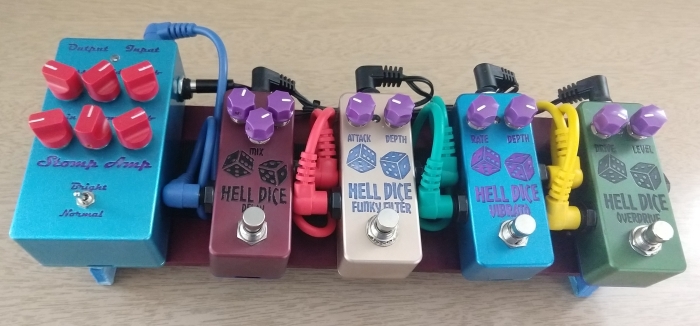I have been performing way more than I use to! I play club gigs twice a week or more these days…and as a result, my relationship with my rig has really changed. Which is to say, my perspective on what I actually use and what features matter most, has evolved. My conclusions are these: I want small, light weight rugged equipment…I don’t want too many knobs or complexity. I like to use a few basic settings and sounds and that is it. So I have designed a compact amplifier and set of small 1590a form factor pedals to create a complete amplifier/pedal board rig that weighs a couple of pounds and is about 12 inches long and 4 inches wide. It includes: My 100 watt stomp amp with an auxiliary 9 volt output, a high performance PT2399 type delay, a simple but really nice sounding LDR based envelope filter, A very pleasing two stage LDR phase shift Vibrato and a hex inverter based overdrive with slightly different approach than the typical design.
My New Compact Pedal Board

As an aside all of these pedals are made with machined(not die cast) Hammond sized aluminum enclosures from Ebay (alpinetech), which I etched and anodized. You cannot properly anodize die cast enclosures because of other ingredients that are mixed with the aluminum…so you have to get CNC milled enclosures if you want to anodize the enclosures. I discussed my home anodizing process here: Anodizing discussion
More Pictures:


Links to Schematics and Design Notes:
A few notes: Many of the part choices are not critical..like transistors, op amps and voltage regulators I use.. The LDR based effects will need tweaking based on the output efficiency of the LED/photo-resistor combo or if you use a commercial opto-coupler instead. The vibrato uses my pic based LFO…but it can easily be replaced with other LFO circuits. The delay uses a 8 pole switch cap filter IC but if desired, this can be replaced by using the unused op amp on the PT2399 IC as a low pass filter.
Pedal Board Demos From Live Show:
Demo of Delay and Vibrato:
Demo of Envelope Filter(two minutes in):




